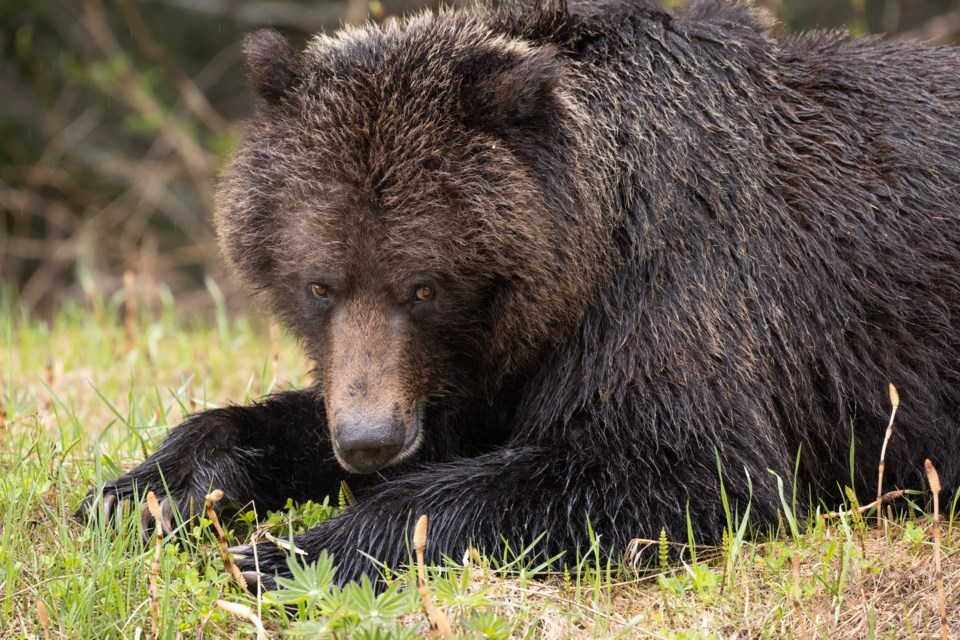Regional wildlife authorities fronted up to the Squamish-Lillooet Regional District’s (SLRD) latest committee of the whole meeting to talk about bears and the way the community interacts with them, in response to public safety concerns in the Sea to Sky and around Pemberton.
Conservation Officer Service (COS) Inspector Simon Gravel spoke to requests from the community the SLRD is receiving to do with grizzly bear activity, and specifically in the Pemberton Meadows area, saying growing bear populations will come with challenges.
“Culturally, we’re not used to this in recent time in SLRD—I would say the cultural tolerance for grizzly bears is fairly low,” he said at the Feb. 29 meeting, adding the community is “complacent and used to having black bears, but when a grizzly bear shows up, the perspective and the cultural tolerance is very different.
“When a grizzly bear shows up in our landscape and they interface with a residential area, the role of COS is to mitigate public safety,” he said.
Gravel said a bear by itself is not a safety concern, and the COS’ job is to simply assess why it is there, “and mitigate it to make sure we’re not dealing with an immediate threat that can cause harm to a resident.”
He said COS officers will respond when a threat is imminent and it is obvious bear behaviour is a threat to residents’ safety—but threat levels can be perceived differently.
“For us, a bear that is very habituated to people and food-conditioned will be higher on the scale of public safety. A bear that causes a lot of damage or tries to access a building that is occupied is obviously high on the spectrum of public safety,” he said.
“A bear walking by, a bear on the landscape, a bear in a field, a bear seeking food—that is natural bear behaviour, and doesn’t necessarily trigger a response from the conservation officer service. Education in those cases is the first response.”
He added the COS doesn’t have the capacity to respond to all calls, especially when it is just to report a bear in the area.
“As you know, we’re extremely busy,” he said. “The increase in conflict in the area is ongoing, the increase of visitors and so on … we need to prioritize and really stay focused on our core mandate.”
There is a gap between what the public expects and what the COS is capable of doing within its mandate, Gravel added.
One effort to fill that gap is the Wildlife Safety Response Officer (WSRO) program.
Calvin Rochon, who is a WSRO in the Sea to Sky, said the program was designed to mitigate conflict through education and public outreach, and notably, contact residents who make reports that don’t trigger a COS response.
Rochon is employed by the COS, but the position is funded municipally.
Speaking to the program, Rochon said the key to reducing conflict is early reporting that could lead to education.
“Often in my experience with many years of dealing with bears, it’s 90, 95 per cent not a bear problem, it’s often a person problem,” he said, referring to access to unnatural food sources for bears and perception of danger.
Problem bears are often reported too late, he added.
“I find people … haven’t been calling until the timeline is quite late in habituation,” he said.
Calling in late could result in a COS response, as public danger could be higher, and the killing of the animal more likely.
Squamish Mayor Armand Hurford asked when residents should be calling in bears, given the message that bears just existing in an area are not a danger, while calling in early is encouraged, and was told it is important that people call in bears so the COS can build a conflict history.
That way they can track the behaviour of a bear, even if initial calls don’t trigger a response.
Concerned Pemberton locals and experts from the Coast to Cascades Grizzly Bear Initiative are still calling for the creation of a designated Grizzly Bear Management Specialist position in the Sea to Sky corridor. The call comes as families in Pemberton Meadows say they are living in fear of a nearby grizzly and her cubs, after children in the area have reportedly come face to face with the bear while playing outside.
At Pemberton’s March 5 committee of the whole meeting, Mayor Mike Richman asked Rochon to comment on the grizzly interactions in Pemberton over the last year.
“There has been quite a big increase in grizzly bears,” said Rochon. “With the increase in population, it is going to keep increasing. There needs to be some sort of coexistence. The awareness needs to be there. People are looking for some sort of solution to it.
“I’m not saying that [the WSRO] is guaranteed going to be the one, but it will bring more education and outreach. There is a sow that’s going to keep coming around [to Pemberton Meadows].”
The COS report to the SLRD committee of the whole can be watched on the SLRD YouTube channel.
-with files from Roisin Cullen




